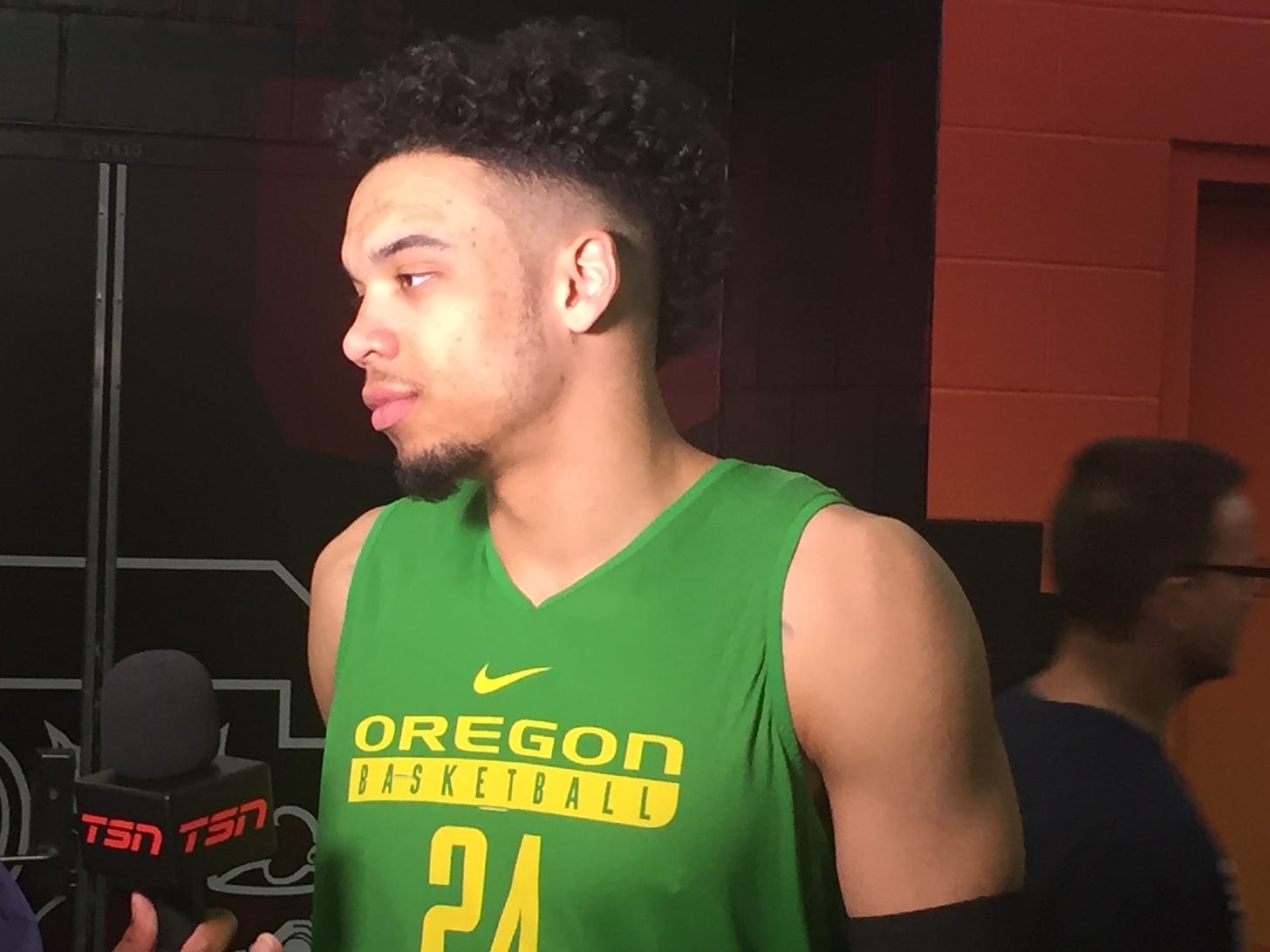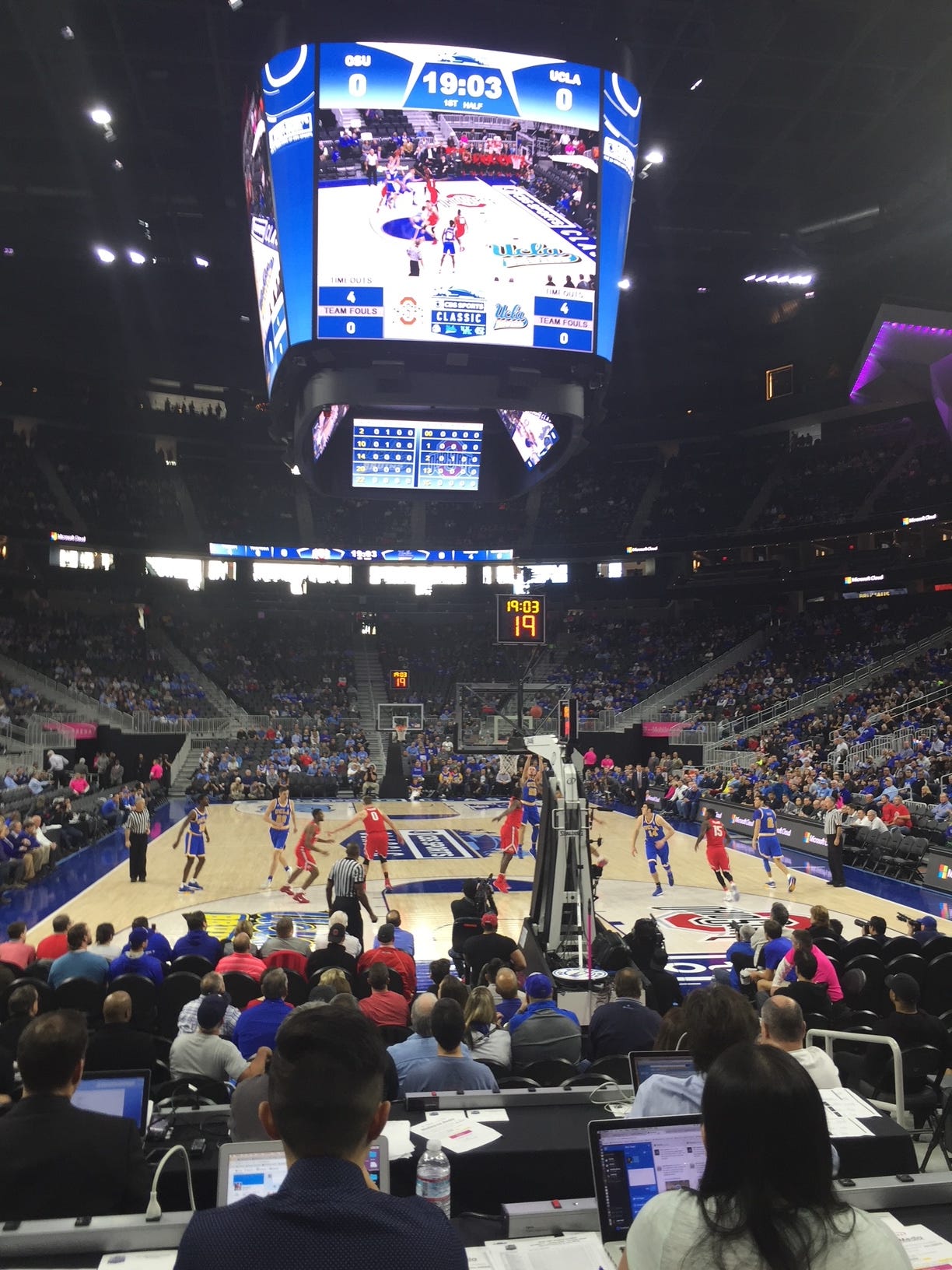The Pac is Back! Now, How Does it Stick Around?
Pac-12 basketball's NCAA Tournament success needs to capitalized on.
The Pac-12 emerging as perhaps the top story of the 2021 NCAA Tournament provides a drop of vindication for your humble author.
In the interest of transparency, I must disclose I have lived my entire life in the Pac-12 footprint and graduated from a Pac-12 university, where as a child I attended its basketball camp and spent summers in my undergraduate years working as a counselor. With that disclaimer out of the way, I don’t see myself as a Pac-12 honk.
I do, however, smack my head (metaphorically…barely) when the annual wave of columns from national outlets begin anew. Is it now the Power Four?!? isn’t an original take, but it’s certainly nuclear.
The 2020 Pac-12 Championship Game
Alas, college football playing the shortest season — three months, essentially — yet needing to feed one of the more voracious content machines creates an environment conducive to half-baked yet red-hot takes the longer the offseason drags on.
The yearly Pac-12 eulogies start to appear in the spring, May or June, when the offseason is at its most vacuous lull. While often centered around football, the NCAA Tournament and basketball season are fresh enough in minds that the Pac-12’s March performance in recent years factors into these contrived debates.
Now, before getting into actual competitive performance, I’ll quickly debunk the asinine Power Four?! argument and charges of the Pac lagging behind financially.
In 2020, Pac-12 members received roughly $32 million each in revenue share. Despite the conference having the oldest media-rights contract among the five leagues, brokered in 2010, its distribution still outpaced the ACC by member, and was about equivalent to that of the Big 12.
The SEC and Big Ten receive astronomic sums, the Big Ten in particular, but reality is those two conferences will always generate more revenue by virtue of their alumni-base size and fan-base passion.
Meanwhile, even the least lucrative of the Power Five rights deals draws exponentially more than the highest-paying of the Group of Five contracts, that of the American Athletic Conference. There’s no genuine comparison to be made, and attempts to suggest otherwise are intellectually dishonest.
With that boring yet necessary bit of housekeeping out of the way, let’s talk what actually matters to spectators: on-field and on-court results.
The "Power Four” nonsense is an easier sell given the undeniable struggles of the Pac-12 in football and basketball in recent years. A 2017 football season in which only a single Pac member won its bowl game led directly into a March Madness with three winless Pac-12 teams bowing out early.
2017-18 has remained the whatever-is-opposite-of-gold standard by which conference ineptitude is measured. It doesn’t help that in 2018-19, despite Pac-12 teams rebounding with four combined NCAA Tournament wins, and an important in football bowls to around .500, the Pac’s basketball regular-season champion was a No. 9 seed and its tournament winner (and only Sweet 16 squad) was a 12. And football has yet to produce a Playoff participant since the 2016 season.
Measuring conference success through a single-elimination tournament beholding to matchups and some luck, or on exhibition games in which teams rarely have their full rosters, doesn’t provide the most accurate picture. At the same time, Pac-12 basketball was undeniably down the previous few years with or without Tournament results, and Pac-12 football has lacked the flag-bearer program counterparts that arguably lack the Pac’s depth have had: the ACC Clemson, Big Ten Ohio State and Big 12 Oklahoma.
Building to that level in football is considerably more difficult than basketball. The Playoff being limited to four spots, and at least two of the Power conferences having pace-setters that are so far above the rest of their competition on a yearly basis, punishes a league for depth and competitive balance.
What’s more, the size of football rosters leaves a program having to produce multiple outstanding recruiting classes consecutively. Oregon’s on the right track, and the Ducks might break through in 2021. But it’s no guarantee.
In basketball, a program can land a single standout signing class and become an immediate contender. But, this isn’t necessarily a feasible, long-term plan and the Pac-12 suffered for following it.
Rewind to 2016-17, the basketball season not mentioned when burying the Pac-12. In the 2017 NCAA Tournament, all four Pac teams in the field — Arizona, Oregon, UCLA and USC — won at least two games. Three of the four advanced to the Sweet 16, with USC coming a possession away against Baylor from doing so, and Oregon reached the Final Four.
Were it not for a missed box-out at the free-throw lane in the final seconds against North Carolina, Oregon may well have played in the 2017 National Championship Game.
Dillon Brooks at the 2017 Final Four in Glendale, Arizona.
In the subsequent offseason, Arizona, Oregon and UCLA underwent considerable roster change. Oregon’s departures were a mix of early-entries into the NBA draft — Dillon Brooks, Jordan Bell and Tyler Dorsey — and graduates Dylan Ennis and Chris Boucher.
Oregon has yet to return to that level, and understandably so with as much NBA talent as it lost. Brooks and Boucher in particular have made marks on the pro game, with Boucher making some inroads toward the Most Improved Player Award.
But the Ducks remain at the forefront of the conference in the years since because Dana Altman has avoided relying heavily on one-and-done talent. Contrast UO with Arizona and UCLA.
In ‘17, Arizona built around Lauri Markannen. He and Kobi Simmons went pro after a single season. UCLA built around Lonzo Ball and T.J. Leaf, both of whom left. Sean Miller transitioned to a team built around Deandre Ayton, another freshman. Ayton was individually outstanding, but Arizona underachieved comparative to its talent level. A sluggish start reflected chemistry issues and doomed UA to an unfavorable seed in the Tournament.
Steve Alford attempted to reload but the 2017-18 UCLA signing class lacked difference-makers the caliber of Ball and Leaf. And both programs have spent portions of the last few years attempting the quick-fix with prospects projected as one-and-done.
Structuring teams around one-and-done caliber talent is a risky proposition. Kentucky under John Calipari has been the most noteworthy example of building around one-and-dones. The Wildcats have a national championship and Final Four appearances in 2011, 2014 and 2015 to go with the 2012 title, but Kentucky also has absolute dud seasons like 2013 and this past.
Mike Krzyzewski has refocused his recruiting at Duke to attract more of the blue-chippers destined to leave after one season, and its produced the Jahlil Okafor/Justise Winslow title team of 2015, Elite Eights in 2018 and 2019 with Gary Trent Jr./Marvin Bagley III and Zion Williamson/R.J. Barrett. But this past season exposed the risk inherent with year-after-year roster turnover.
Arizona is experiencing the drawbacks to routine turnover, too. While the ongoing investigation into recruiting violations has limited UA in the three years since ‘18, Sean Miller still landed a top 3 class in 2019.
But the 2019-20 Wildcats were thoroughly middling, and the departures of one-and-dones Josh Allen, Nico Mannion and Zeke Nnaji, none of whom were poised to make immediate splashes in the NBA, stripped the UA roster down once again.
Alford’s attempts to replicate the success of ‘17 failed, leading to his dismissal and the hire of Mick Cronin. Cronin’s Sweet 16 squad is made up of veteran players who have grown into prominence and feed off of each other.
Colorado and Oregon State both were centered around seniors this season, McKinley Wright and Ethan Thompson. Oregon’s roster is loaded with experience: Eugene Omoruyi, Chris Duarte and LJ Figueroa are all seniors, and Will Richardson is a junior.
Programs don’t need to avoid one-and-done talent altogether: USC may be the Pac-12 team most poised for a Final Four run thanks to potential No. 1 overall pick and freshman Evan Mobley. But Mobley’s style fits well within a team dynamic that’s constructed off of veteran players like Drew Peterson, Tahj Eaddy and big bro Isaiah Mobley.
The NCAA Tournament’s high-pressure atmosphere rewards veteran teams. Every championship winner since Duke’s 2015 title featured a nucleus of third-to-fifth-year guys, players like Ryan Arcidiacono, Josh Hart, Kris Jenkins, Daniel Ochefu; Joel Berry II, Kennedy Meeks; Jalen Brunson, Phil Booth, Eric Paschall; Kyle Guy, DeAndre Hunter, Jack Salt, Ty Jerome.
Certainly homegrown talent helps. All of those championship programs featured stars who developed within the program. The Pac-12’s current success is owed in large part thanks to the transfer portal, with aforementioned talents like Figueroa, Duarte, Richardson, Eaddy and Peterson all coming in from elsewhere, and UCLA’s dynamic scorer Johnny Juzang having left from the one-and-done mill of Kentucky.
It’s not a new phenomenon, either. The soul of Arizona’s Elite Eight teams in 2014 and 2015 was Duquesne transfer T.J. McConnell. Oregon’s Ennis and Boucher were both transfers.
With the portal as loaded as it is this offseason, expect Pac-12 programs to continue utilizing the transfer market to its advantage in the 2021-22 season.
Las Vegas’ T-Mobile Arena is becoming a reliable home for Pac-12 basketball.
Visibility from a season like this will help, and visibility in general will be crucial for the conference to continue flourishing. Bringing it full circle back to TV contracts, the Pac-12’s is inarguably suspect, thanks in part to the lack of distribution for the Pac-12 Network.
The league’s refusal to budge on a price point, in part because its San Francisco location commanded such a high price tag, left countless conference games out of the public eye.
Larry Scott’s removal as conference commissioner earlier this year and the Pac’s Tournament success are coincidental, but the former could help build the latter. The Pac-12 Network is a great idea in concept, particularly the exclusive ownership of the Tier 3 rights among league members. We have yet to see any evidence that ESPN owning the rights of the ACC Network — or, perhaps more comparable to what would happen with the Pac-12, the exists-in-name-only Big 12 Network — means a dramatic uptick in revenue or visibility.
Getting out of the economic sinkhole that is The City and moving to somewhere like Las Vegas, where the Pac-12 is already planting a flag through its conference tournament and football championship, would allow for more wiggle room on distribution prices.
More visibility for the quality of basketball, like the nation is getting through this NCAA Tournament, is a must.






